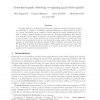Free Online Productivity Tools
i2Speak
i2Symbol
i2OCR
iTex2Img
iWeb2Print
iWeb2Shot
i2Type
iPdf2Split
iPdf2Merge
i2Bopomofo
i2Arabic
i2Style
i2Image
i2PDF
iLatex2Rtf
Sci2ools
WG
2010
Springer
2010
Springer
Generalized Graph Clustering: Recognizing (p, q)-Cluster Graphs
Cluster Editing is a classical graph theoretic approach to tackle the problem of data set clustering: it consists of modifying a similarity graph into a disjoint union of cliques, i.e, clusters. As pointed out in a number of recent papers, the cluster editing model is too rigid to capture common features of real data sets. Several generalizations have thereby been proposed. In this paper, we introduce (p, q)-cluster graphs, where each cluster misses at most p edges to be a clique, and there are at most q edges between a cluster and other clusters. Our generalization is the first one that allows a large number of false positives and negatives in total, while bounding the number of these locally for each cluster by p and q. We show that recognizing (p, q)-cluster graphs is NP-complete when p and q are input. On the positive side, we show that (0, q)-cluster, (p, 1)-cluster, (p, 2)-cluster, and (1, 3)-cluster graphs can be recognized in polynomial time.
-cluster Graphs | Graph Theoretic Approach | Real Data Sets | Theoretical Computer Science | WG 2010 |
| Added | 31 Jan 2011 |
| Updated | 31 Jan 2011 |
| Type | Journal |
| Year | 2010 |
| Where | WG |
| Authors | Pinar Heggernes, Daniel Lokshtanov, Jesper Nederlof, Christophe Paul, Jan Arne Telle |
Comments (0)

